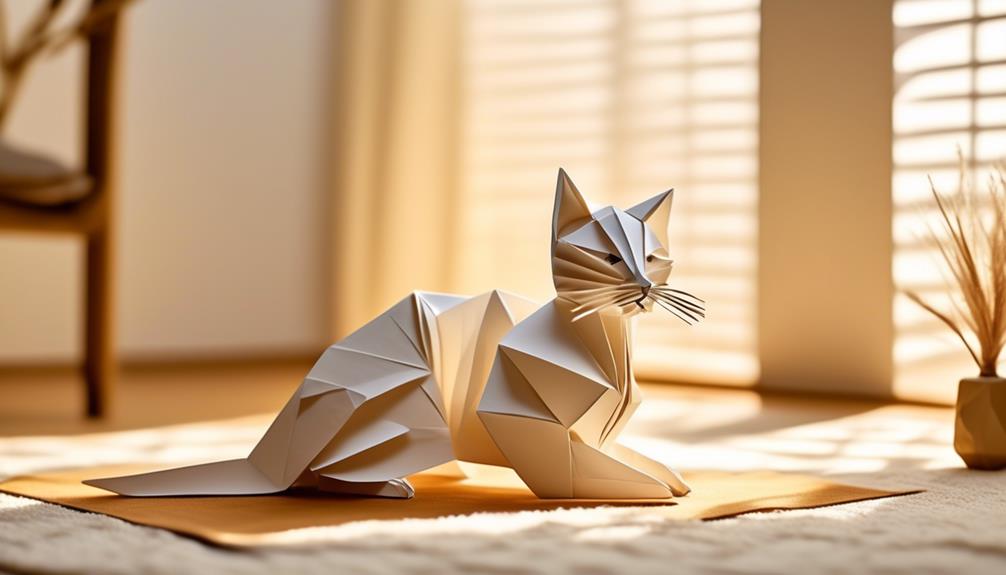As your cat ages and becomes less active, it’s essential to adjust their activities to suit their evolving needs, ensuring their physical and mental health remains a priority.
The five easy exercise routines I’m about to share with you are designed to keep your aging cat engaged, limber, and content without overexerting their senior limbs. Each routine is a stepping stone to preserving their zest for life, and I’ll walk you through how to blend them seamlessly into your daily interactions.
Stay with me, and let’s explore how these simple changes can make a significant impact on your beloved pet’s golden years.
Key Takeaways
- Incorporate gentle stretching exercises and massages to enhance flexibility and maintain circulation in aging cats.
- Engage in interactive play using wand or teaser toys to encourage healthy movement and stimulate hunting behaviors.
- Integrate stimulating puzzle toys to provide mental stimulation and merge physical activity with rewards.
- Encourage natural behaviors through play, by providing cat towers for climbing and jumping, and safer alternatives to string toys for batting and chasing.
Gentle Stretching Techniques
As your Senior Cat’s caregiver, you can easily integrate a routine that incorporates gentle stretching techniques, ensuring their golden years are filled with ease and mobility.
Start with their neck, tenderly guiding your cat’s head from side to side, allowing them to feel a mild, relieving stretch. This simple movement can make a world of difference in their daily comfort.
Next, with loving care, massage your cat’s legs. This not only improves circulation but also aids in maintaining flexibility, which is so crucial for their well-being.
To encourage your cat to naturally extend their body, use a favorite treat or toy to coax them into reaching upward. This form of cat exercise isn’t only beneficial but also engaging for your cat. Be there to support their weight as they lean into the stretch, ensuring they’re safe and comfortable as they reach for a raised treat.
Remember to provide a soft, padded surface for these activities. It’s the perfect setting for your cat to stretch out fully and comfortably, making each gentle extension a moment of pure bliss for their aging body.
Interactive Play Sessions
Engage your senior cat’s curiosity and zest for life with interactive play sessions that captivate their senses and encourage healthy movement. As they age, it’s vital to keep their minds sharp and their bodies agile, and the right kind of play can do just that.
In your interactive play sessions, tease your cat with wand or teaser toys adorned with feathers. They mimic the fluttering of birds, igniting their instinctual hunting behaviors. Every pounce and leap is a step towards maintaining their health. Intertwine play with love and patience, and you’ll see their spirit flourish.
Here’s a guide to enriching your senior cat’s playtime:
| Type of Toy | Purpose | Benefit |
|---|---|---|
| Wand/Teaser Toys | Stimulate hunting instinct | Encourages physical activity |
| Catnip Toys | Provide sensory excitement | Heightens playtime engagement |
| Puzzle Toys | Mental stimulation | Keeps the mind sharp, offers treats |
| Climbing Condo | Simulate natural climbing | Promotes exercise, satisfies urges |
Don’t forget to include scratching posts in your interactive play—these are essential for your cat’s need to scratch, stretch, and stay active. Your love and dedication to their well-being shine through every gentle play session, fostering a bond that enriches both your lives.
Stimulating Puzzle Toys
Adding puzzle toys to your older cat’s daily activities can make them happy and keep their mind sharp. These toys are made to challenge your cat in a fun way, offering treats when they figure them out. Watching your older cat play with these toys and use both their natural instincts and intelligence to get treats can be very enjoyable.
To enhance your cat’s experience, consider these thoughtful suggestions:
- Introduce treat-dispensing puzzle toys to merge physical activity with the pleasure of a reward.
- Opt for puzzle toys with adjustable difficulty levels, so you can tailor the challenge to your cat’s unique abilities and keep them from feeling discouraged.
- Rotate different puzzle toys to maintain a fresh sense of curiosity and prevent mental stagnation.
Encouraging Natural Behaviors
While puzzle toys provide valuable mental exercise, nurturing your aging cat’s instincts through play that encourages natural behaviors is equally vital for their overall well-being. Introducing new and novel toys can spark their curiosity and motivate them to engage in the playful antics that come so naturally to them.
Instead of string toys, which pose a risk if ingested, consider safer alternatives that allow them to bat around and chase, mimicking the thrill of the hunt.
Invest in cat towers that enable your cat to jump and climb, satisfying their instinctual desire to survey their domain from a high vantage point. These activities not only keep their bodies agile but also offer a sense of security and control, which is essential for their emotional health.
Guided Walking Routines
To support your aging cat’s mobility and curiosity, consider establishing a guided walking routine that provides gentle exercise and mental stimulation in the safety of their familiar surroundings. As your cat grows older, maintaining an active lifestyle becomes increasingly important for their overall well-being.
Here’s how you can create a nurturing and supportive environment for your older cat to walk and explore:
- Prepare a Safe Path: Clear any obstacles in a designated area to create a safe walking path. Ensure it’s free from hazards that could startle or harm your senior pet.
- Harness and Leash: Fit your cat with a comfortable harness and attach a leash to guide them gently. This helps you control the pace and direction while ensuring they don’t wander into trouble.
- Short and Sweet Sessions: Start with brief walking sessions, keeping an eye on your cat’s comfort level. Gradually extend the time as they grow accustomed to the routine, always allowing for rest when needed.
Walking your cat provides a beautiful opportunity to bond and serve their needs. Check with your vet to tailor the guided walking routines to your cat’s health, and remember, a little encouragement goes a long way. Shower them with affection and perhaps a treat or two to make each step a rewarding experience.
Frequently Asked Questions
How Do I Get My Senior Cat to Exercise?
To encourage your senior cat to move, start slowly, similar to the gentle flow of a lazy river. Use interactive toys to pique their interest and set up comfortable areas where they can climb, creating a safe space for their daily activities.
How Much Exercise Does a Senior Cat Need?
Your senior cat needs about 10-15 minutes of exercise, several times a day. It’s vital to keep them moving, but always watch their energy to prevent any strain. A vet’s advice is invaluable.
How Can I Help My Senior Cat Mobility?
To keep your senior cat on the move, gently encourage play with interactive toys and create a stimulating environment with climbing options. Always check with your vet to tailor activities to your cat’s needs.
How Do You Keep an Older Cat Entertained?
You keep your older cat entertained by introducing variety, like new toys, and scheduling playtime when they’re naturally more active. Vertical spaces and rotating toys also help maintain their interest and happiness.




